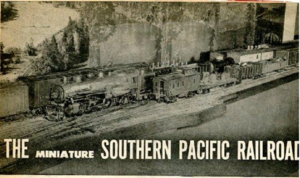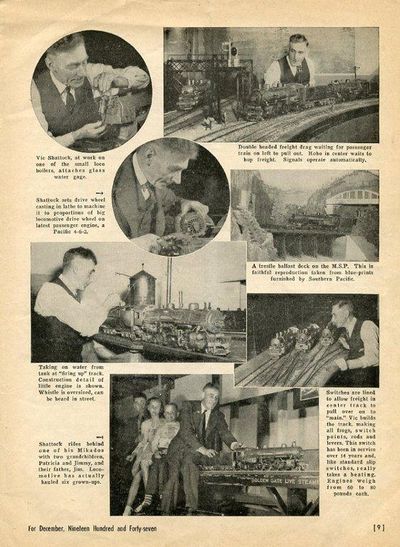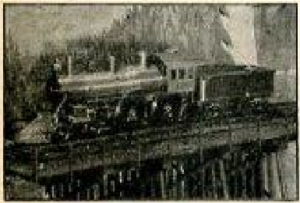The Miniature Southern Pacific Railroad
The following appeared in "The Brotherhood of Maintenance of Way Employees Journal", December 1947.
The Miniature Southern Pacific Railroad
Vic Shattock, Oakland, Calif., is a water service foreman on the Western Division of the Southern Pacific Company (Pacific Lines), and is one of the many who believes a man should have a hobby of some kind if he hopes to keep old age from getting in his licks too soon. Vic's hobby is building miniature steam railroads.
It would appear that railroading is hereditary with Vic for his father, now enjoying life at the grand age of 88, is a retired railroader having been employed as a station master on the Great Western Railway of England for over 47 years. Vic was also employed on the Great western Railway of England for three years before he immigrated to Canada and then to the United States, where he has been employed by the Southern Pacific Company since 1923.
Miniature railroading has become a very popular hobby in our country and Vic can justly claim to the one of its foremost pioneers. He has built a complete railroad system in the basement of his home in Oakland, Calif., which is regarded by the thousands of visitors as the real thing. Unlike the popular type which have electric motors in their boilers, Vic's engines are powered by steam. The locomotives snort, hiss and whistle like the big standard monsters which haul the trains over the country.
Like the big railroads, the "Miniature Southern Pacific" had a modest beginning. Twenty off years ago while employed as water service repairman, Vic constructed a railroad with tracks running the full length of his 50-foot outfit car. The rail was made of wire and equipment comprised a few box and flat cars and two small locomotives. Since that time the "Miniature Southern Pacific" has really taken shape for it boasts five powerful steam locomotives, twenty-three cars and a host of other features which go to make up a modern pike.
The railroad is built to the scale of 17/32" to the foot or approximately 1/24th full scale. The track gauge is 2-12".
Realistic Roadbed
Entering the basement door the first thing to catch your eye is the roadbed set up about waist high carrying the track with correct shape 120 lb. rail, ties and ballast, circling the 45 x 30-foot basement. Along one 45-foot side is a three-track section containing a combination slip switch, passing tracks and spurs leading into each corner of the basement for storage of cars and the making up of trains. back of the furnace is the roundhouse graced by an electrically operated model of a 110-foot turntable which is used to turn the engines to and from their stalls to the "firing up" track and water tank, and from there to the main line. After leaving the yard the main line is single track running over a trestle ballast deck, through a tunnel, over a steel girder bridge along the other 45-foot side of the basement to the first switch leading to a passing track near the basement door. here is located a water column for the benefit of thirsty engines. Set out on the right of way, behind the water plug, is a dismantled car body presumably for the use of the pumper. The main line continues on under signal bridges, past yard limit and reduce speed signboards and onward through the yard. Switches are hand operated by properly proportioned switch stands and ground switch levers. The block signals, lights and semaphores operate electrically and automatically in accordance with the location of trains.
The rolling equipment is mainly patterned after Southern Pacific practice, hence the name "Miniature Southern Pacific", comprises box cars, gondolas, hopper dump car, tanks, flats and stock cars, one caboose and one passenger coach, 23 in all, and when coupled back of a locomotive makes up a train over 40 feet long. All cars are mounted on springs and are very true to scale, doors open and close and have automatic couplers. The hopper car has side and center dump doors and was actually used to ballast the track when construction work was going on.
The outstanding feature of the "Miniature Southern pacific" is the steam-powered locomotive, which is the last word in small steam engine constructions. There is one Consolidation, wheel arrangement, 2-8-0, two Mikados or "Mikes", 2-8-2, and two Pacifics, 4-6-2, the latter being high-wheel passenger engines. There was a switcher, 0-6-0, but someone came in through a basement window and stole this engine about 18 months ago. The boiler, a very important item on any steam engine, is made of copper throughout, and all seams, joints and stays are brazed for additional strength and the use of copper is to eliminate all possibility of rust. The boilers are jacked with asbestos and sheet brass and constructed along the lines of their big brothers, that is, with water legs around the firebox and flue tubes leading to the front end or smoke box. The working pressure used is from 80 to 100 pounds per square inch; the safety valves are set at 100 pounds and they "pop" quite frequently during a run.
Boilers Get Tests
Following construction, each boiler is subjected to a hydraulic test of 250 pounds per square inch, which if O.K. ensures no danger of them blowing up while under steam. Each boiler is equipped with water and steam pressure gauges, whistle, safety valve, throttle and jet blower located in the front end under the stack which creates the draft for steam raising. Coal can be used as fuel for these boilers bu Vic has designed a burner for denatured alcohol which he finds more convenient. The liquid is carried in the tender and is piped to the burner in the firebox through a control valve where the liquid is turned into gas and burns with a terrific heat.
Vic has written several articles describing this burner which have been published for the benefit of steam engine builders.
When under steam the engines are running, the feed water is pumped into the boiler from the tender by an axle-driven pump which automatically preserves the correct water level in the boiler. When the engine is standing, a steam-operated pump, located under the cab floor, is used to replenish the boiler. The steam dry pipe leads from the dome to the throttle and superheater elements to the cylinders. The cylinders are cast from hard bronze which are bored to 3/4" or 7/8" depending upon the type of locomotive and the stroke is usually 1-1/8" or 1-1/4". In some instances, slide valves are used but on the later engines Vic has built he has fitted correct pattern piston valves. Walschaert's valve gear operates the valves and is a true copy of the valve gear on a big locomotive.
Wheels of Cast Iron
The drive wheels are cast in iron, as are all the wheels, and then machined to proper sizes; the freight engines' drivers are 2-5/8" and the passenger engine drive wheels are 3-3/8" diameter. Weight of engine and tender in working order is about 75 lbs.
While these little locomotives are used to haul trains on the basement railroad, this does not constitute the extent of their hauling power. Vic has demonstrated on numerous occasions that they will haul himself and three or four adults riding behind on flat cars. At two hobby shows, held in the Oakland City Auditorium, tracks were laid on benches about two feet high and hundreds of people took advantage of the opportunity to take a ride. It is almost inconceivable that these little machines will haul a load of 700 pounds, but it has been done and witnessed by thousands of people.
The fact that Vic builds these engines from start to finish has brought him acclaim from all over the country and he is known for his outstanding work in this field. Each part of these engines and cars is made in his basement workshop; boiler fittings, boilers, wheels, frames, in fact, everything with the exception of the steam pressure gauges, which he has made for him.
He has been interviewed on the radio, both locally and nationally, the latter when he appeared on "Hobby Lobby." This was during 1938 when he took one of his "Mikes" to New York and fired it up in Radio City before an audience of 250 guests and the barks from the exhaust, the sounds from the cylinder drain cocks and the whistle were broadcast over a national hook up. He is proud of the fact that he has a locomotive that has been heard all over the country. Only recently, during a convention of model railroads from all over the country and Canada, nearly 200 of these rail enthusiasts visited his basement to see the "Miniature Southern Pacific" in operation.
Questioned as to the time and money expended on his hobby, Vic says the cost for material is very low. Material for track cost about $50 and each locomotive, calling for the purchase of stock materials such as copper, brass, steel rod, rivets and small bolts and nuts amounts to about $60. It is the time element that would be expensive if paid for as it requires about 1,000 hours to build one of these engines. This is, of course, spare time; the work would proceed much faster by putting in a regular eight-hour day. The cars are fairly easy to make and wood for the bodies can be used from boxes or similar material. Most of these were made when his two sons, Ron and Jim, were attending school and they assisted dad a great deal in making up cars, signals and other railroad items. Ron did most of the electric work in connection with the block signal operation and the electric mechanism of the turntable. Since that time, the boys have married and their wives keep them too busy around their homes to spare much time for the "Miniature Southern Pacific."
Details of Turntable
The turntable is quite a piece of work in itself. It is built true to scale and contains nearly 2,000 rivets in the steel girder structure. It has a planked deck and pipe hand rails which necessitated the making of 32 small pipe hangers, 32 crosses and 30 tees, the pipe being stock brass tubing. The power for the motor which is geared to drive wheels is brought in by overhead wires through a distributor in much the same manner as is done for the full-size table. The motor is reversible and permits the table to be turned in any direction. It took several months of spare-time work to build but is a necessary gadget and has given very little trouble in the 15 years it has been in use.
Blueprints for obtaining principal dimensions of engines and cars and other equipment have been furnished by Southern Pacific Company and parts of his equipment have been placed on display in their ticket offices and other places from time to time.
Our story of the "Miniature Southern Pacific" would not be complete without mention of Vic's friend and co-worker, Walter Brown. Walter and Vic are bosom buddies and can always be found together in Vic's basement toying with the "live steamers." Also a craftsman, Walter has constructed several locomotives but none quite as famous as the 999 which is an exact reproduction of the New York Central engine bearing the same number. here is the 999 crossing the dry creek trestle on the "Miniature Southern Pacific" lines.
Many a boy has nursed a childish dream to some day be a railroad engineer, and such ambition has often been realized. Vic Shattock, no doubt, had similar childhood desires, but to rise to the position of general manager, superintendent, trainmaster, engineer, track foreman and sole owner of a miniature steam railroad, would be the life-long ambition of any young American. Numerous magazines have carried stores of Vic's railroad and the tribute paid him was well earned. Unless one can see the "Miniature Southern pacific" in operation, it is difficult to visualize the detailed beauty of these small giants as they perform to the master touch of their owner. Each a true replica of the full-size locomotives in exact detail is truly a sight long to be remembered.
It may appear that Vic does nothing else but work on his railroad. Such is far from the case. For the past ten years he has been president of a club which imparts information to budding locomotive builders who meet at his home once a month. He is a co-chairman of a standard committee of the National Model Railroad Association. He is a member of two fraternal organizations and is secretary-treasurer of lodge 407, which has a big membership, a position he has held since 1934. In addition, he was Division Grievance Committee Chairman in 1933 and member of the Joint Protective Board of the Pacific Federation. He was elected to Assistant General Chairman in 1944, and filled the position of General Chairman for six months on account of the illness of General Chairman Tom Finneran. He resigned from Division Chairman in 1945 and from Assistant General Chairman in 1946. He is, however, very active in Brotherhood matters.


